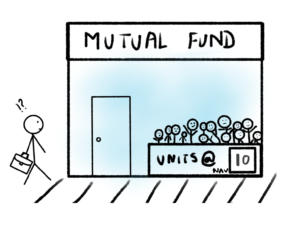Retirement planning as a concept has been picking up in the recent past. The terminology has changed though. Retirement is generally seen as connected to old-age when we think about it which we want to avoid. So, there is a new word now which is used in conjunction, especially when talking to youngsters and this financial freedom!
We may say that retirement is something which was not planned by the previous generations of our parents and grand-parents. They had just taken to it as it came to them, so what’s the big deal now?

Imagine if you were going to buy equity shares of a blue-chip company yourself and along with that buy shares of another 100 companies for diversification. The kind of research you may have to do could be overwhelming. It can also be very expensive to buy and hold such companies, as for a few companies, buying just one share can cost a lot of money. Mutual funds make it easier for us. There is a fund manager for every scheme who has a team of research analysts who decide which companies to buy and sell and have it in their portfolio. Every scheme has a fund objective and they operate within those guidelines. Mutual funds are also heavily regulated by SEBI and the fund companies are subject to regular reporting and regulations. All this is convenience is for a fee known as Total Expense Ratio (TER) which the fund charges for managing your money, subject to the maximum amount which can be charged, depending on the type of fund and size of the fund.
At the end of the day, every day, the price of a mutual fund share (known as net asset value (NAV) per share), is declared for each of the schemes by the fund house. NAV is calculated by dividing the total value of the securities in the portfolio by the total amount of shares outstanding. Open ended funds can be purchased or redeemed at the fund’s current NAV. One difference from stock prices is that the NAV does not fluctuate during market hours, but it is settled at the end of each trading day. However, the Exchange Traded Funds (ETF) are different wherein they are settled at the time of transaction during the trading hours and not at the end of the day.
Investments are managed by experts. So, that is a big advantage as the research is done by the team. What we need to ensure is that we buy a relevant fund considering the objectives of the schemes, our risk appetite, and the time horizon available for achieving the objectives.
As mentioned previously, it can be very expensive to buy even a single share of all the holdings. A mutual fund makes it easier since we can own even a fraction of a share, as the entire money is pooled in from various investors and then the purchases are done.

Since mutual funds buy and sell in large volumes, the transaction costs for an investor can be very low.
We can achieve optimal diversification in a scheme since a mutual fund would invest across various companies depending on the objectives of the scheme. A multi-cap fund, as an example, would be invested across large-cap, mid-caps, and small caps. We can obtain further diversification by investing across different categories of mutual funds based on our own goals.
Other than the tax saving schemes or the closed-ended schemes, there is no lock-in and their liquidity is very high. Mutual funds can be bought or sold very easily.
Mutual funds are regulated by SEBI. The fund value of the various schemes needs to be declared by the end of the day and therefore it is a very transparent investment.
Mutual fund investments are tax effective. By investing in tax saving schemes, we get a tax rebate for our investments. The capital gains are zero or very low subject to various conditions which we can discuss in one of our future blogs.

You must have read the standard terms and conditions that returns in mutual funds cannot be guaranteed or promised. Equity funds are subject to market risks, whereas debt mutual funds could be subject to interest, duration, and credit risks. However, investing based on research and our goals can help us manage these risks effectively.
Mutual funds can be expensive as compared to buying a stock directly, but that compensates for the ease and the professional management and all other advantages mentioned previously. This can be a low cost considering the convenience of investing in a mutual fund.
As an investor, there is no control on what investments we would like the fund manager to do. All the decisions are taken by the fund manager. But that is fine, else what is the purpose of hiring a professional manager. So, if an investor wants to invest in a Shariah compliant fund (fund with restrictions of not investing in particular sectors), then the choices can be very limited. Though there are Portfolio Management Schemes (PMS) and hedge funds which are available that can customize the investments, do know that the charges for maintaining those accounts can be extremely high and there is also a very large minimum ticket size for investment.
Before October 2017, there were too many fund categories. Often the names of schemes were also confusing wherein the objectives of the scheme were not clear. Too many funds added to all the confusion. That’s when SEBI stepped in to make it easier for the investors to understand the different categories of mutual funds. Fund categories were classified and standardised. Large Caps companies were considered as the top 100 companies by way of market capitalisation, the next 150 companies were mid-cap companies and everything thereafter was small-cap. So, the yardstick across companies was standardised. The sub-categorisation was also standardised mentioning the scheme characteristics.
As per SEBI circular released in October 2017, there are now a total of 38 fund categories across 5 broad groups. While we may still argue that these are a lot more than desired, there has been some thought in outlining a structure around it. The categorisation is given below:
| S. No. | Group | Scheme Categories | Comments |
| 1 | Equity Schemes | 11 Categories: Large Cap, Mid Cap, Small Cap, Large & Mid Cap, Multi Cap, Dividend Yield, Focused, Value, Contra, Sector/Thematic, ELSS | Classification based on percentage allocation across different types of equities. Also, either a contra or a value fund is permitted |
| 2 | Debt Schemes | 16 Categories: Overnight, Liquid, Ultra Short Duration, Low Duration, Money Market, Short Duration, Medium Duration, Medium to Long Term, Long Duration, Dynamic Bond, Corporate Bond, Credit Risk, Banking & PSU Bond, Gilt, Gilt with 10-year Constant Duration, Floater | Classification done based on duration, interest rate and credit risks. |
| 3 | Hybrid Funds | 7 Categories: Conservative Hybrid, Balanced Hybrid, Aggressive Hybrid, Dynamic Asset Allocation or Balanced Advantage, Multi-Asset Allocation, Arbitrage, Equity Savings | Classification based on a mix of various asset class types |
| 4 | Solution Oriented Schemes | 2 Categories: Retirement, Children’s | Products with lock-in for long term solution-oriented goals |
| 5 | Other Schemes | 2 Categories: Index Funds/ETFs, FoFs (Overseas / Domestic) | Investment is in index fund or a fund which invests in other funds |
Only one scheme per category is permitted. Following are the exceptions:
It is beyond the scope of this write-up to get into the details of every scheme category. The SEBI circular has all the details and can be accessed at this location: https://bit.ly/SEBI_Circular
Based on category, goals, and own risk appetite. The ability to choose from various funds across the same category becomes critical.
Fund characteristics cannot be changed without informing investors and then an exit route needs to be provided if they do not agree.
The list of funds available as large-cap or mid-cap remains same for all the schemes and is now based on market capitalization, reviewed every six months. Earlier, what was large-cap for one fund, could have been a mid-cap in another fund, not so now.
Categorization simplified based on maturity tenure, credit risk, and interest rate risks.
Funds have been labelled as conservative, balanced or aggressive, based on their equity composition.
This was a primer for having a basic understanding of the mutual funds and the categorization. Do know that the comparison of a fund returns across long term may now not be relevant as fund categorization itself may have changed. So, there needs to be a lot of subjectivity too in the analysis before zeroing on a fund for which you may want to invest. Knowing where and when to invest is much more important than doing the transactions. The investments which are done should be aligned to your various financial goals. You may want to hire the services of a financial planner or a financial advisor if you consider this too overwhelming.
As always, your comments and feedback are welcome. You can read more blogs on personal finance on my website.